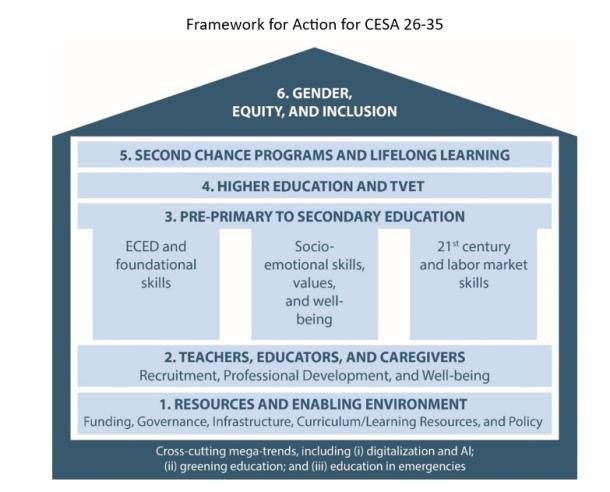Teachers are at the center of the new Continental Strategy for Education in Africa 2026 to 2035 (CESA 26-35)
This blog post is co-authored by Sophia Ashipala, Head for Education at the African Union Commission, and Quentin Wodon, Director of UNESCO’s International Institute for Capacity Building in Africa.
Education remains a top priority for Africa. As part of work carried under the Year of Education in 2024, the African Union conducted a review of the Continental Education Strategy for Africa 2016-2025 (CESA 16-25) and prepared a new strategy for 2026-2035 (CESA 26-35). The new strategy was approved at the African Union’s summit in February 2025 and is now available on the website of the African Union. Separately, the African Union also approved a new strategy for Technical and Vocational Education and Training (TVET), also now available online.
CESA 26-35 comprises of four parts: (1) A brief investment case; (2) A review of selected challenges; (3) A framework for action; and (4) A discussion on governance, communications, and monitoring. Part I for the investment case considers (i) Human rights, peace and sustainable development, including considerations related to gender, equity, and inclusion; (ii) Health and social benefits; and (iii) Labor market benefits. Part II reviews progress (or the lack thereof) for schooling and learning, as well as the links between both. It also provides a summary of key findings from the CESA 16-25 review. Part III is the core of the strategy. It provides a framework for action with six strategic areas of focus and 20 objectives. Part IV is about governance, communications, and data for monitoring and evaluation (M&E).
Teachers are at the core of CESA 26-35, with three objectives under the second strategic area in the strategy that focuses on teachers. These three objectives are: (1) Improve teacher policies, education, professional development, and accountability; (2) Increase the attractiveness of the teaching profession; and (3) Invest in school leadership including the share of female leaders where needed. The other five strategic areas under CESA 26-35 focus on (i) Resources and the enabling environment; (ii) Pre-primary to secondary education, with a focus on early learning and foundational, socio-emotional, and 21st century and labor market skills; (iii) Higher Education and TVET; (iv) Second chance programs and lifelong learning; and (v) Gender, equity, and inclusion. Several cross-cutting themes are also mentioned, including (1) digitalization and AI; (2) greening education; and (3) education in emergencies.
A simple visual aims to facilitate communications around strategic areas. The Figure below conveys the idea that education systems must be built, like a house or structure. The first two strategic areas, including the area focusing on teachers, are the foundations, followed by three pillars combined into one strategic area. These pillars relate to the foundational, socio-emotional, and 21st century skills that learners must acquire, especially through pre-primary to secondary education. Those skills also need to be emphasized at higher levels of learning, as well as in second chance programs and lifelong learning, but the period from pre-primary to secondary education is essential. Next come educational opportunities through Higher Education and TVET, and programs for children and youth out of school and for lifelong learning for adults. The roof and outside walls that encompass the whole system must ensure gender-transformative approaches, equity, and inclusion. Finally, the text at the base of the structure highlights a few critical mega-trends that education systems must adapt and respond to.

In total, CESA 26-35 has 20 objectives, a smaller than the Action Areas (AAs) in the previous strategy for 2016 to 2025 (CESA 16-25), in part to convey prioritization. For each objective, the strategy provides a brief explanation of the importance of the objective and links to guidance related to promising interventions and approaches for achieving the objective. UNESCO IICBA played an important role in working with the African Union to draft the strategy and conduct an extensive consultation process before its approval.
As CESA 26-35 is now approved and available online, the next steps will consist in planning its dissemination and implementation. A first implementation meeting with members of the CESA task force was organized in Nairobi in May 2025. On matters related to teachers, the CESA teacher professional development cluster is in the process of providing additional guidance. For example, along CESA 26-35, a separate strategy was adopted by the African Union on mental health and psycho-social support (MHPSS) for teachers in Africa.
In future articles for this newsletter, we will provide more details on the MHPSS strategy and the broader implementation plans for CESA 26-35, especially as they pertain to the teaching profession in Africa.

